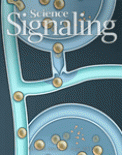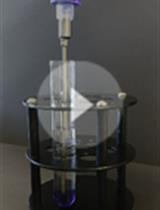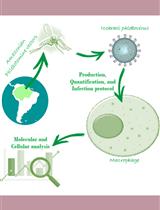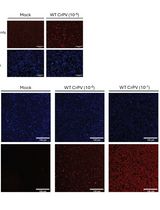- EN - English
- CN - 中文
Sendai Virus Propagation Using Chicken Eggs
利用鸡蛋进行仙台病毒的繁殖
发布: 2018年09月20日第8卷第18期 DOI: 10.21769/BioProtoc.3009 浏览次数: 6805
评审: Longping Victor TseMasfique MehediGeorge William Carnell
Abstract
Sendai virus is a member of the family Paramyxoviridae, and an enveloped virus with a negative-stranded RNA genome. Sendai virus is not pathogenic to humans, but for mice and can cause pneumonia in mice. Easy and efficient techniques for propagating Sendai virus are required for studying virus replication, virus-induced innate- and adaptive-immunity, Sendai-virus-based virotherapy and IgA nephropathy. Here, we describe a protocol for Sendai virus propagation using chicken eggs. This traditional protocol enables us to generate a large amount of virus enough for animal experiments as well as cell culture experiments in a relatively inexpensive way.
Keywords: Sendai virus (仙台病毒)Background
Sendai virus (SeV) is a mouse parainfluenza virus type 1 that was discovered in Sendai, Japan, in the 1950s (Ishida and Homma, 1978). The virus was once named Hemagglutinating Virus of Japan (HVJ) by the Japanese Society for Virology, but was later termed ‘newborn virus pneumonitis (type Sendai)’ (Kuroya and Ishida, 1953). The name SeV is currently most popular, and now understood to be a pathogen of mice, not humans (Karron RA, 2007). Fukumi et al. first described SeV infections of mice in 1954 (Fukumi et al., 1954). This infection can be subclinical, but SeV is also known as one of the leading causes of pneumonia in certain mouse strains (Fukumi et al., 1954; Parker et al., 1978). SeV is an excellent tool to study the following in the various fields: the pathomechanism of a murine model of IgA nephropathy (Yamashita et al., 2007; Chintalacharuvu et al., 2008), a stimulator of RIG-I/MDA5 in innate immunity (Fensterl et al., 2008; Chattopadhyay et al., 2010, 2011 and 2013; Yamashita et al., 2012a, 2012b and 2013), oncolytic SeV-based virotherapy (Saga and Kaneda, 2015), a respiratory infection (Hermesh et al., 2010 and 2012), and a vector for AIDS vaccine (Ishii and Matano, 2015). SeV is uniquely sensitive to interferon-associated responses, and grows to high titers in both chicken eggs and in FDA-approved mammalian cell lines, an advantage for vaccine production. This protocol provides a method for SeV propagation using chicken eggs. This method can be applied for viral propagation for other viruses such as influenza virus.
Materials and Reagents
- 3 ml disposable transfer pipette (Bioland Scientific, catalog number: TPP02-11 )
- Centrifuge bottles, 250 ml (Fisher Scientific, catalog number: 05-564-1)
Manufacturer: Thermo Fisher Scientific, catalog number: 3141-0250 . - Bucket with ice
- 25 G 5/8 needle (Fisher Scientific, catalog number: 14-826AA)
Manufacturer: BD, catalog number: 305122 . - 1 ml syringes (BD, catalog number: 309659 )
- 18 G needle (Fisher Scientific, catalog number: 14-826-5G)
Manufacturer: BD, catalog number: 305195 . - 50 ml syringe (Fisher Scientific, catalog number: 14-955-461 )
- Pencil
- Push pin (Staples, catalog number: 480117 )
- Face mask (Cellucap Manufacturing, catalog number: 1826EL )
- Iodine Wipes (Dynarex, catalog number: B003U463PY )
- Egg holder/case (provided with embryonated eggs, or you can obtain regular ones from grocery store when you purchase regular/unembryonated eggs)
- Chicken embryonated eggs (48 eggs, 9-10 days old) (Charles River, catalog number: 10100332 )
- Duco® Cement Multi-Purpose Household Glue (ITW Consumer, Duco Cement, catalog number: 62435 )
- Sendai virus stock (ATCC, catalog number: VR-105 or catalog number: VR-907 )
- PBS with Ca2+ and Mg2+ (Thermo Fisher Scientific, catalog number: 14040133 )
- 70% ethanol
- Bleach (Essendant, catalog number: CLO30966CT )
- 0.5 M EDTA (Thermo Fisher Scientific, catalog number: R1021 )
Equipment
- Pipette (200 μl and 1,000 μl; any products are fine)
- Biosafety cabinet (any types are fine if it is BSL2 level)
- 1 L Graduated cylinder (Thermo Fisher Scientific, catalog number: 3664-1000 )
- Egg Incubator (up to 41 eggs; Farm Innovators, Digital Circulated Air Incubator with Auto Egg Turner, model: 4250 )
- Refrigerator/4 °C cold room
- High-speed Centrifuge with fixed-angle rotor of 250 ml bottles (Beckman Coulter, model: Avanti® J-E )
- Sonic water bath (Skymen Cleaning Equipment, model: JP-008 )
- Flashlight (Defiant, catalog number: HD15FL04-3 or Caliburn Lighting, catalog number: PISTOL-TRIPOD-RCH )
- Scissors (World Precision Instruments, catalog number: 14192-G )
- Forceps (World Precision Instruments, catalog number: 501974 )
Procedure
文章信息
版权信息
© 2018 The Authors; exclusive licensee Bio-protocol LLC.
如何引用
Tatsumoto, N., Arditi, M. and Yamashita, M. (2018). Sendai Virus Propagation Using Chicken Eggs. Bio-protocol 8(18): e3009. DOI: 10.21769/BioProtoc.3009.
分类
微生物学 > 微生物细胞生物学 > 病毒繁殖
您对这篇实验方法有问题吗?
在此处发布您的问题,我们将邀请本文作者来回答。同时,我们会将您的问题发布到Bio-protocol Exchange,以便寻求社区成员的帮助。
提问指南
+ 问题描述
写下详细的问题描述,包括所有有助于他人回答您问题的信息(例如实验过程、条件和相关图像等)。
Share
Bluesky
X
Copy link












